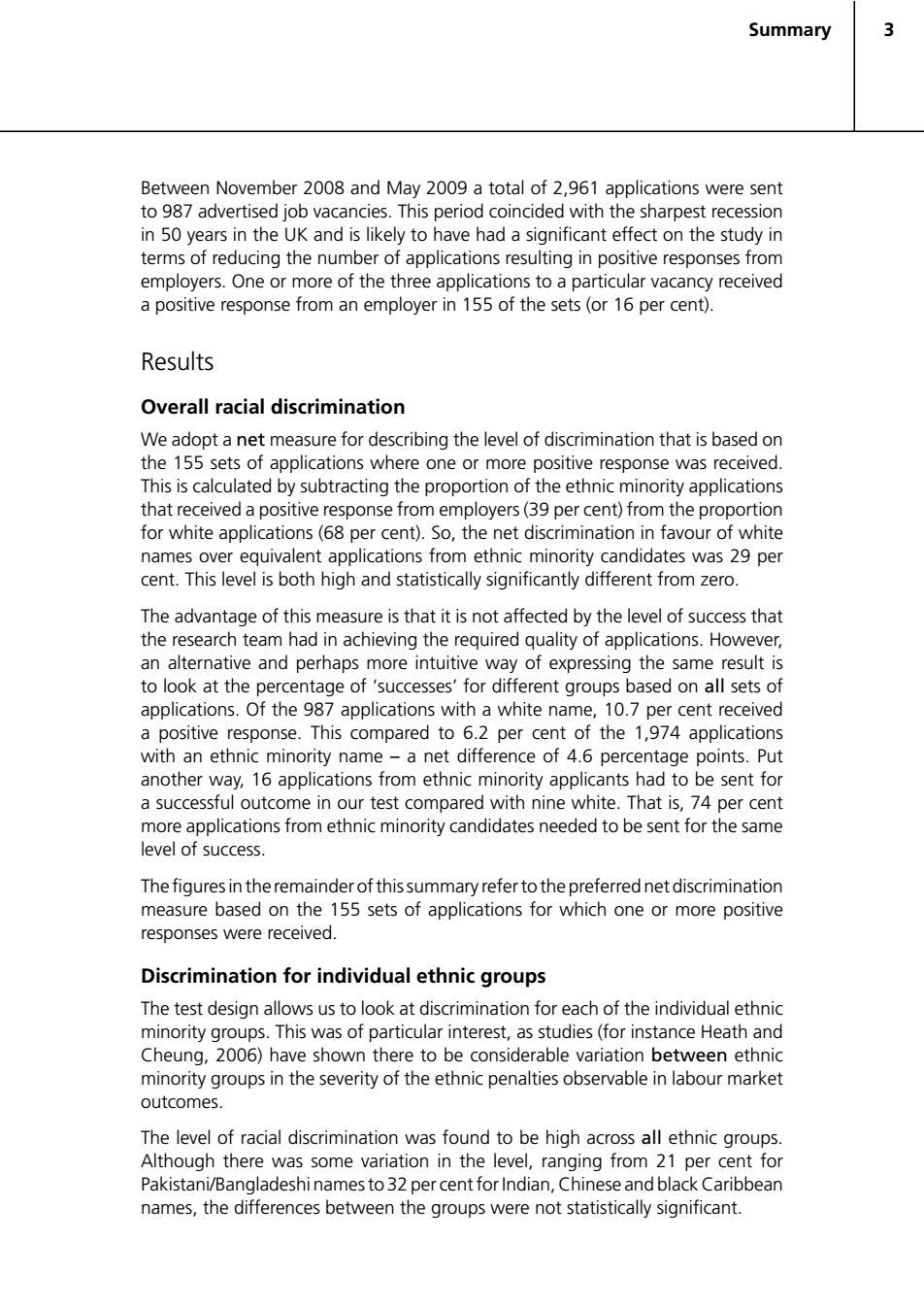正在加载图片...

Summary 3 Between November 2008 and May 2009 a total of 2,961 applications were sent to 987 advertised job vacancies.This period coincided with the sharpest recession in 50 years in the UK and is likely to have had a significant effect on the study in terms of reducing the number of applications resulting in positive responses from employers.One or more of the three applications to a particular vacancy received a positive response from an employer in 155 of the sets (or 16 per cent). Results Overall racial discrimination We adopt a net measure for describing the level of discrimination that is based on the 155 sets of applications where one or more positive response was received. This is calculated by subtracting the proportion of the ethnic minority applications that received a positive response from employers(39 per cent)from the proportion for white applications(68 per cent).So,the net discrimination in favour of white names over equivalent applications from ethnic minority candidates was 29 per cent.This level is both high and statistically significantly different from zero. The advantage of this measure is that it is not affected by the level of success that the research team had in achieving the required quality of applications.However, an alternative and perhaps more intuitive way of expressing the same result is to look at the percentage of 'successes'for different groups based on all sets of applications.Of the 987 applications with a white name,10.7 per cent received a positive response.This compared to 6.2 per cent of the 1,974 applications with an ethnic minority name-a net difference of 4.6 percentage points.Put another way,16 applications from ethnic minority applicants had to be sent for a successful outcome in our test compared with nine white.That is,74 per cent more applications from ethnic minority candidates needed to be sent for the same level of success. The figures in the remainder of this summary refer to the preferred net discrimination measure based on the 155 sets of applications for which one or more positive responses were received. Discrimination for individual ethnic groups The test design allows us to look at discrimination for each of the individual ethnic minority groups.This was of particular interest,as studies(for instance Heath and Cheung,2006)have shown there to be considerable variation between ethnic minority groups in the severity of the ethnic penalties observable in labour market outcomes. The level of racial discrimination was found to be high across all ethnic groups. Although there was some variation in the level,ranging from 21 per cent for Pakistani/Bangladeshi names to 32 per cent for Indian,Chinese and black Caribbean names,the differences between the groups were not statistically significant.Summary 3 Between November 2008 and May 2009 a total of 2,961 applications were sent to 987 advertised job vacancies. This period coincided with the sharpest recession in 50 years in the UK and is likely to have had a significant effect on the study in terms of reducing the number of applications resulting in positive responses from employers. One or more of the three applications to a particular vacancy received a positive response from an employer in 155 of the sets (or 16 per cent). Results Overall racial discrimination We adopt a net measure for describing the level of discrimination that is based on the 155 sets of applications where one or more positive response was received. This is calculated by subtracting the proportion of the ethnic minority applications that received a positive response from employers (39 per cent) from the proportion for white applications (68 per cent). So, the net discrimination in favour of white names over equivalent applications from ethnic minority candidates was 29 per cent. This level is both high and statistically significantly different from zero. The advantage of this measure is that it is not affected by the level of success that the research team had in achieving the required quality of applications. However, an alternative and perhaps more intuitive way of expressing the same result is to look at the percentage of ‘successes’ for different groups based on all sets of applications. Of the 987 applications with a white name, 10.7 per cent received a positive response. This compared to 6.2 per cent of the 1,974 applications with an ethnic minority name – a net difference of 4.6 percentage points. Put another way, 16 applications from ethnic minority applicants had to be sent for a successful outcome in our test compared with nine white. That is, 74 per cent more applications from ethnic minority candidates needed to be sent for the same level of success. The figures in the remainder of this summary refer to the preferred net discrimination measure based on the 155 sets of applications for which one or more positive responses were received. Discrimination for individual ethnic groups The test design allows us to look at discrimination for each of the individual ethnic minority groups. This was of particular interest, as studies (for instance Heath and Cheung, 2006) have shown there to be considerable variation between ethnic minority groups in the severity of the ethnic penalties observable in labour market outcomes. The level of racial discrimination was found to be high across all ethnic groups. Although there was some variation in the level, ranging from 21 per cent for Pakistani/Bangladeshi names to 32 per cent for Indian, Chinese and black Caribbean names, the differences between the groups were not statistically significant